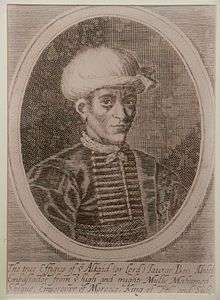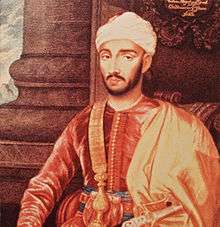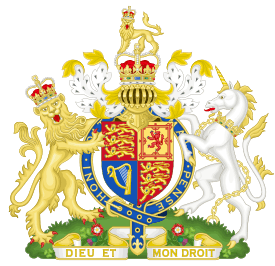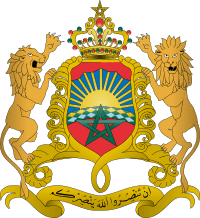Morocco–United Kingdom relations
 |
|
Morocco |
United Kingdom |
|---|---|
Morocco – United Kingdom relations cover a period from the 13th century to the present day.
First exchanges
According to some accounts, in the beginning of the 13th century King John of England (1167–1216) sent an embassy to the Almohad Sultan Muhammad al-Nasir (1199–1213), requesting military support and an alliance against France.[1] At home, King John was faced with a dire situation, in which his Barons revolted against him, he had been excommunicated by the Pope, and France was threatening to invade. The embassy of three was led by Bishop Roger, and King John supposedly offered to convert to Islam and pay a tribute to al-Nasir in exchange for his help. Al-Nasir apparently dismissed the proposal.[2]
Anglo-Moroccan alliance
Relations developed following the sailing of The Lion to Morocco in 1551. According to Richard Hakluyt, quoting Edmund Hogan, ruler "Abdelmelech" (Abu Marwan Abd al-Malik I Saadi) bore "a greater affection to our Nation than to others because of our religion, which forbids the worship of Idols".[3]
In 1585, the establishment of the English Barbary Company, trade developed between England and the Barbary states, and especially Morocco.[4][5] Diplomatic relations and an alliance were established between Elizabeth and the Barbary states.[6] Queen Elizabeth sent her Minister Roberts to the Moroccan emperor Ahmad al-Mansur to reside in Morocco and obtain advantages for English traders.[7]
England entered in a trading relationship with Morocco detrimental to Spain, selling armour, ammunition, timber, metal in exchange for Moroccan sugar, in spite of a Papal ban.[8] prompting the Papal Nuncio in Spain to say of Elizabeth I: "there is no evil that is not devised by that woman, who, it is perfectly plain, succoured Mulocco (Abd-el-Malek) with arms, and especially with artillery".[9]
1600 embassy



In 1600, Abd el-Ouahed ben Messaoud, the principal secretary to the Moroccan ruler Mulai Ahmad al-Mansur, visited England as an ambassador to the court of queen Elizabeth I.[11] Abd el-Ouahed ben Messaoud spent six months at the court of Elizabeth, in order to negotiate an alliance against Spain.[12] The Moroccan ruler wanted the help of an English fleet to invade Spain, Elizabeth refused, but welcomed the embassy as a sign of insurance, and instead accepted to establish commercial agreements.[13][14] Queen Elizabeth and king Hamad continued to discuss various plans for combined military operations, with Elizabeth requesting a payment of 100,000 pounds in advance to king Hamet for the supply of a fleet, and Hamet asking for a tall ship to be sent to get the money. Discussions however remained inconclusive, and both rulers died within two years of the embassy.[15]
A treaty signed in 1728 extended these privileges, especially those pertaining to the safe-conduct of English nationals.[16]
See also
Notes
- ↑ Britain and Morocco during the embassy of John Drummond Hay, 1845–1886 by Khalid Ben Srhir, Malcolm Williams, Gavin Waterson p.13
- ↑ History of Islam (Vol 3) by Akbar Shah Najeebabadi, p.188-189
- ↑ Shakespeare: The critical complex by Stephen Orgel p.293
- ↑ Vaughan, p.57
- ↑ Nicoll, p.90
- ↑ Nicoll, p.90
- ↑ Cawston, p.226
- ↑ Speaking of the Moor, Emily C. Bartels p.24
- ↑ New Turkes by Matthew Dimmock p.122 Note 63
- ↑ In the lands of the Christians by Nabil Matar, back cover ISBN 0-415-93228-9
- ↑ Vaughan, p.57
- ↑ Vaughan, p.57
- ↑ Vaughan, p.57
- ↑ Nicoll, p.90
- ↑ Nicoll, p.96
- ↑ Cawston, p.226
References
- Virginia Mason Vaughan Performing Blackness on English Stages, 1500–1800 Cambridge University Press, 2005 ISBN 0-521-84584-X
- Allardyce Nicoll Shakespeare Survey. The Last Plays Cambridge University Press, 2002 ISBN 0-521-52347-8
- George Cawston, Augustus Henry Keane, The Early Chartered Companies (A.D. 1296–1858) The Lawbook Exchange, Ltd., 2001 ISBN 1-58477-196-8
 Ambassador Admiral Abdallah ben Aisha, 1685.
Ambassador Admiral Abdallah ben Aisha, 1685. Moroccan Ambassador Mohammed Ben Ali Abgali in 1725.
Moroccan Ambassador Mohammed Ben Ali Abgali in 1725. Ambassador Admiral Abdelkader Perez, 1723–1737.
Ambassador Admiral Abdelkader Perez, 1723–1737. Ambassador Zebdi 1876.
Ambassador Zebdi 1876.

